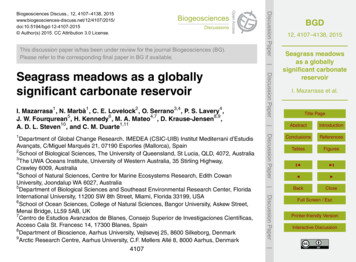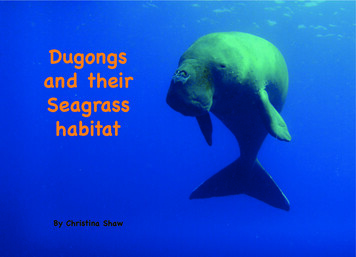
Transcription
This discussion paper is/has been under review for the journal Biogeosciences (BG).Please refer to the corresponding final paper in BG if available.Discussion PaperBiogeosciences Discuss., 12, 4107–4138, i:10.5194/bgd-12-4107-2015 Author(s) 2015. CC Attribution 3.0 License. 1123,4412, 4107–4138, 2015Seagrass meadowsas a globallysignificant carbonatereservoirI. Mazarrasa et al.Title PageAbstractDepartment of Global Change Research. IMEDEA (CSIC-UIB) Institut Mediterrani d’EstudisAvançats, C/Miguel Marqués 21, 07190 Esporles (Mallorca), Spain2School of Biological Sciences, The University of Queensland, St Lucia, QLD, 4072, Australia3The UWA Oceans Institute, University of Western Australia, 35 Stirling Highway,Crawley 6009, Australia4School of Natural Sciences, Centre for Marine Ecosystems Research, Edith CowanUniversity, Joondalup WA 6027, Australia5Department of Biological Sciences and Southeast Environmental Research Center, FloridaInternational University, 11200 SW 8th Street, Miami, Florida 33199, USA6School of Ocean Sciences, College of Natural Sciences, Bangor University, Askew Street,Menai Bridge, LL59 5AB, UK7Centro de Estudios Avanzados de Blanes, Consejo Superior de Investigaciones Científicas,Acceso Cala St. Francesc 14, 17300 Blanes, Spain8Department of Bioscience, Aarhus University, Vejlsøvej 25, 8600 Silkeborg, Denmark9Arctic Research Centre, Aarhus University, C.F. Møllers Allé 8, 8000 Aarhus, DenmarkDiscussion PaperConclusions Back4107 1Discussion Paper I. Mazarrasa , N. Marbà , C. E. Lovelock , O. Serrano , P. S. Lavery ,564,78,9J. W. Fourqurean , H. Kennedy , M. A. Mateo , D. Krause-Jensen ,101,11A. D. L. Steven , and C. M. DuarteDiscussion PaperSeagrass meadows as a globallysignificant carbonate ICloseFull Screen / EscPrinter-friendly VersionInteractive Discussion
CSIRO, EcoSciences Precinct – Dutton Park 41 Boggo Road Dutton Park QLD 4102,Australia11Red Sea Research Center, King Abdullah University of Science and Technology, Thuwal23955-6900, Kingdom of Saudi ArabiaReceived: 19 December 2014 – Accepted: 24 January 2015 – Published: 6 March 2015Discussion Paper10Correspondence to: I. Mazarrasa (imazarrasa@imedea.uib-csic.es) Published by Copernicus Publications on behalf of the European Geosciences Union.Discussion Paper12, 4107–4138, 2015Seagrass meadowsas a globallysignificant carbonatereservoirI. Mazarrasa et al.Title Page AbstractIntroductionDiscussion PaperConclusionsReferencesTablesFiguresJIJI BackCloseDiscussion Paper 4108BGDFull Screen / EscPrinter-friendly VersionInteractive Discussion
5Seagrass meadowsas a globallysignificant carbonatereservoirI. Mazarrasa et al.Title sFiguresJIJI BackCloseDiscussion Paper 410912, 4107–4138, 2015Discussion Paper25BGD 20Discussion Paper15 10There has been a growing interest in quantifying the capacity of seagrass ecosystemsto act as carbon sinks as a natural way of offsetting anthropogenic carbon emissionsto the atmosphere. However, most of the efforts have focused on the organic carbon(POC) stocks and accumulation rates and ignored the inorganic carbon (PIC) fraction,despite important carbonate pools associated with calcifying organisms inhabiting themeadows, such as epiphytes and benthic invertebrates, and despite the relevancethat carbonate precipitation and dissolution processes have in the global carboncycle. This study offers the first assessment of the global PIC stocks in seagrasssediments using a synthesis of published and unpublished data on sediment carbonateconcentration from 402 vegetated and 34 adjacent un-vegetated sites. PIC stocks inthe top 1 m sediments ranged between 3 and 1660 Mg PIC ha 1 , with an averageof 654 24 Mg PIC ha 1 , exceeding about 5 fold those of POC reported in previousstudies. Sedimentary carbonate stocks varied across seagrass communities, withmeadows dominated by Halodule, Thalassia or Cymodocea supporting the highest PIC 1 1stocks, and tended to decrease polewards at a rate of 8 2 Mg PIC ha degreeof latitude (GLM, p 0.0003). Using PIC concentration and estimates of sedimentaccretion in seagrass meadows, mean PIC accumulation rates in seagrass sediments 2 1is 126.3 0.7 g PIC m y . Based on the global extent of seagrass meadows (177 0002to 600 000 km ), these ecosystems globally store between 11 and 39 Pg of PIC in the 1top meter of sediment and accumulate between 22 and 76 Tg PIC y , representinga significant contribution to the carbonate dynamics of coastal areas. Despite that thesehigh rates of carbonate accumulation imply CO2 emissions from precipitation, seagrassmeadows are still strong CO2 sinks as demonstrates the comparison of carbon (POCand POC) stocks between vegetated and adjacent un-vegetated sediments.Discussion PaperAbstractFull Screen / EscPrinter-friendly VersionInteractive Discussion
5Seagrass meadowsas a globallysignificant carbonatereservoirI. Mazarrasa et al.Title sFiguresJIJI BackCloseDiscussion Paper 411012, 4107–4138, 2015Discussion Paper25BGD 20Discussion Paper15Calcium carbonate (CaCO3 ) accounts for about a 25 % of the surface marinesediments (Balch et al., 2005). Contemporary oceanic carbonate sediments are mainlycomposed by two main mineral forms of calcium carbonate, calcite (including Mgcalcite, magnesium-rich calcite) and aragonite, both primarily formed by biogenicprecipitation (Smith, 2013). The coastal ocean accounts for around 33 % of the globalCaCO3 production (Smith, 2013) but it is where the highest proportion of carbonatesediment accumulation takes place (nearly two-thirds of its production) whereas inopen ocean sediments only one-third of the CaCO3 produced is accumulated (Millimanand Droxler, 1996; Smith, 2013). A broad range of communities is involved in theproduction and subsequent accumulation of CaCO3 in marine sediments, includingbenthic ecosystems dominated by coral reefs (Chave et al., 1972; Smith, 2013),calcareous algae (Milliman, 1993) and maerl beds (Bosence and Wilson, 2003);and planktonic communities including coccolithophores (Westbroek et al., 1989),foraminifera (Langer et al., 1997), and pteropods (Fabry, 1990). More recently theimportant contribution of echinoderms (Lebrato et al., 2010), molluscs (Chauvaud et al.,2003) and fish (Wilson et al., 2009) to CaCO3 production has been revealed. Relative toother ecosystems, the production and accumulation of CaCO3 in seagrass sedimentsis poorly studied and not explicitly considered in any of the existing assessments ofthe global ocean carbonate budget (Milliman et al., 1993; Milliman and Droxler, 1996;Lebrato et al., 2010), despite the important load of carbonate often found in theirsediments and leaves (Canals and Ballesteros, 1997; Gacia et al., 2003; Perry andBeavington-Penney, 2005; Serrano et al., 2012; Enriquez and Schubert, 2014) andtheir role as a source of carbonate sand for beach formation and preservation (De Falcoet al., 2003; Tigny et al., 2007). Indeed, a global estimate of the carbonate stock inseagrass sediments is not yet available and the potential contribution of these systemsto the global ocean carbonate budget remains to be evaluated. 10IntroductionDiscussion Paper1Full Screen / EscPrinter-friendly VersionInteractive Discussion
4111 12, 4107–4138, 2015Seagrass meadowsas a globallysignificant carbonatereservoirI. Mazarrasa et al.Title PageAbstractIntroductionDiscussion PaperConclusionsReferencesTablesFiguresJIJI BackCloseDiscussion Paper25BGD 20Discussion Paper15 10Discussion Paper5There is considerable interest in quantifying the capacity of the World’s ecosystemsto trap and store carbon, as this can offset anthropogenic carbon emissions tothe atmosphere. To date, most work on the carbon pools in seagrass ecosystems hasfocused on the amount of particulate organic carbon (POC) stored (Fourqurean et al.,2012; Lavery et al., 2013) whereas, except for Posidonia oceanica in the MediterraneanSea (Serrano et al., 2012), the inorganic component, particulate inorganic carbon(PIC), has not yet been considered in the assessment of carbon deposits inseagrass meadows. Seagrass ecosystems support diverse and active communities ofcalcifying organisms and through their photosynthetic activity their canopies provide pHenvironments that facilitate carbonate deposition (Hendriks et al., 2014). While PIC, inthe form of shells and other skeletal remains represent a substantial carbon stock, theproduction of PIC through calcification may act as a source of CO2 to the atmosphere(Frankignoulle et al., 1994; Gattuso et al., 1998; Smith, 2013). Thus, understanding theamount of carbonate in seagrass ecosystems is crucial to determining their role in theglobal atmospheric carbon cycle. The evaluation of the carbonate accumulation ratesand stocks in seagrass sediments is also relevant as they may significantly contributeto sediment accretion in coastal areas, a fundamental mechanism supporting the roleof seagrass in coastal protection (Duarte et al., 2013).Seagrass meadows accumulate PIC through calcium carbonate production bycalcifying organisms inhabiting the meadows, such as epiphytes (Frankovich andZieman, 1994; Perry and Beavington-Penny, 2005; James et al., 2009; Enríquez andSchubert, 2014) and benthic invertebrates (Jeudy de Grissac and Boudouresque,1985) and the deposition of carbonate associated with sedimentation of particles(Gacia et al., 2003). In addition, a recent study demonstrates a direct implication of theseagrass Thalassia testudinum in the formation of aragonite needles that accumulateinternally in the cell walls and as external deposits on the blades (Enríquez andSchubert, 2014). Other evidence for the existence of active carbonate processes inseagrass beds include calcification and carbonate dissolution in the canopy, associatedwith the daily cycles of photosynthesis and respiration (Frankovich and Zieman, 1994;Full Screen / EscPrinter-friendly VersionInteractive Discussion
Seagrass meadowsas a globallysignificant carbonatereservoirI. Mazarrasa et al.Title eWe compiled the published data available on carbonate stocks in seagrass meadowsand adjacent un-vegetated sediments. We considered the total pool of CaCO3 reportedwithout distinguish between the different possible biogenic carbonate mineral forms(calcite, Mg-calcite and aragonite). Fourqurean et al. (2012) provided data for 201sites, and a literature search using both the Web of Knowledge (using the searchterms “seagrass*” AND “inorganic carbon*” AND [“calcific* OR sediment* OR CaCO3OR dissolut* OR diagenesis”]) and Google Scholar (using the search terms “seagrass4112 IntroductionDiscussion PaperAbstract Material and methods12, 4107–4138, 2015Discussion Paper252BGD 20Discussion Paper15 10Discussion Paper5Barrón et al., 2006; Yates and Halley, 2006), and the dissolution of calcium carbonatein the sediment as a result of below-ground release of CO2 by respiratory processes(Hu and Burdige, 2007).All the processes mentioned (precipitation, dissolution and sedimentation) partiallydepend on seagrass metabolic activity and plant structural features and thus, CaCO3stocks in seagrass sediments are likely to vary across meadows of different species(Duarte, 1991). In addition, CaCO3 stocks in seagrass meadows will likely varywith latitude, as temperature regulates the seawater saturation state for carbonateminerals, that increases with increasing temperature (Zeebe and Ridgwell, 2011)thereby favouring biogenic carbonate precipitation in warmer waters (Mutti and Hallock,2003).Here we provide the first global assessment of the particulate inorganic carbon(PIC) deposits in seagrass ecosystems. We do so through a synthesis of publishedand unpublished data on carbonate stocks in seagrass sediments. We examine thevariability of PIC stocks with biogeographic region, latitude and taxonomic compositionof the seagrass community. We also compare the PIC and POC stocks in seagrassecosystems with those in adjacent un-vegetated sediments, provide a first globalassessment of the PIC : POC ratio over sediment depth profiles and discuss itsimplications for current estimates of CO2 sequestration in seagrass ecosystems.Full Screen / EscPrinter-friendly VersionInteractive Discussion
4113 12, 4107–4138, 2015Seagrass meadowsas a globallysignificant carbonatereservoirI. Mazarrasa et al.Title PageAbstractIntroductionDiscussion PaperConclusionsReferencesTablesFiguresJIJI BackCloseDiscussion Paper25BGD 20Discussion Paper15 10Discussion Paper5carbonate”) yielded data for an additional 83 sites. We amended the database withunpublished values for 152 additional sites sampled by the authors. This yielded a totalof 436 sites with data on sediment carbonate concentration in coastal areas occupiedby seagrasses, of which 34 corresponded to sand patches adjacent to seagrassmeadows. The final database comprised estimates for 402 seagrass vegetated sites, ofwhich 219 consisted of values for sediment surface samples (ca. 1–30 cm depth) and183 consisted of values for sediment cores of variable length (148 cores 100 cm-long,and 35 cores 100 cm-long).The greatest proportion of the sites (46 %) was located in tropical and subtropical regions (20–40 latitude) for both the southern and Northern Hemispheres whereasthe data from higher latitude regions were scarce (Fig. 1). Data on surface sedimentcarbonate was broadly distributed, but most (80 %) core data available was fromsubtropical and temperate seagrass meadows (Fig. 1).Lithogenic characteristics of the sites were not considered in this study, which,thereby, assumes that the seagrass meadows are the source of carbonate stocks intheir sediments. We cannot discard this leading to an overestimation of carbonatedeposition rates in areas where lithogenic carbonate might be important. However,as the biogenic carbonate pool is considered to be the dominant in contemporaryoceanic sediments (Smith et al., 2013), the local geological characteristics might nothave a highly relevant impact in the results of this study.When only one of the variables, CaCO3 or PIC was reported, the other was estimatedassuming that PIC is 12 % of the total molar mass of the CaCO3 . In most cases,particulate inorganic carbon (PIC) was reported as a percentage of dry weight (%DW), 3where PIC, in mg PIC cm , was calculated as the product of the fraction of sedimentdry weight composed by PIC and the dry bulk density (DBD) of a given core section(n 340 sites). When DBD was not reported (n 113 sites), we used the averageDBD (1.03 g cm 3 ) reported by Fourqurean et al. (2012) for seagrass sediments in thecalculations. The error introduced by this assumption was small, as a paired t testrevealed an average deviation of 3.3 % (t ratio 4.32; p 0.0001) when we tested theFull Screen / EscPrinter-friendly VersionInteractive Discussion
4114 12, 4107–4138, 2015Seagrass meadowsas a globallysignificant carbonatereservoirI. Mazarrasa et al.Title PageAbstractIntroductionDiscussion PaperConclusionsReferencesTablesFiguresJIJI BackCloseDiscussion Paper25BGD 20Discussion Paper15 10Discussion Paper5differences between estimating PIC concentration using the observed DBD and theassumption of 1.03 for the sites where an observed DBD was reported.Due to the variability in length of the sediment cores available for the study, mean PICconcentration in seagrass sediments was estimated for the top 10 cm of sediment fora total of 384 sampled sites, for which at least one measure of PIC was reported for thisdepth zone. To estimate the carbonate stock within the top meter of sediment for thetotal database available we assumed a constant concentration of PIC in the top meterfor those cores where shallower profiles were reported, as almost half (46 %) of thelong cores (lenght 100 cm, n 35) showed no significant change in PIC concentrationwith depth within the first top meter and the remaining long cores showed only a slightincrease of 0.011 % DW cm 1 on average.The sites were classified based on (1) the seagrass biogeographic regions describedby Hemminga and Duarte (2000) (North East Pacific, South East Pacific, TropicalWestern Atlantic, North Atlantic, South Atlantic, Mediterranean, Indo-Pacific, Western Pacific and Southern Australia), (2) 10 latitude bins and (3) the genus of the dominantseagrass species (Amphibolis, Halophila, Halodule, Enhalus, Thalassia, Zostera,Posidonia, Syringodium, Thalassodendrum and Cymodocea).PIC and POC concentrations were compared along the sediment depth profiles whenboth variables were reported in the same site (n 391). The depth profile of POC,PIC and POC : PIC within the top meter was explored for the longest cores (length 100 cm) when at least three different data were reported within the top meter (n 26). For those sites from where data for sediments from adjacent vegetated and unvegetated patches were reported (n 34), POC and PIC concentrations were alsocompared.We used a paired sample t test to assess the difference between the frequencydistribution and average of observed values and estimated values of top meter stocksand the difference between PIC and POC across the data set and between adjacentvegetated and un-vegetated patches. Analyses of Variance (ANOVA) and a posthoc Tukey-test were applied to compare the PIC stocks among the biogeographicFull Screen / EscPrinter-friendly VersionInteractive Discussion
I. Mazarrasa et al.Title sFiguresJIJIBackCloseDiscussion Paper 4115Seagrass meadowsas a globallysignificant carbonatereservoir 2512, 4107–4138, 2015Discussion Paper20Particulate inorganic carbon concentration within the top 10 cm of seagrass sediments 3 3ranged between 0.3 and 174 mg PIC cm , with an average of 62.5 1.7 mg PIC cm 3and a median of 54 mg PIC cm (n 384). The PIC stock in the top meter of sedimentin seagrass meadows showed a wide variability, ranging between 3 and 1660 Mg PICha 1 , with an average standard error and a median of 654 24 and 647 Mg PIC 1ha , respectively (n 402; Fig. 2). Estimated stocks (mean SE, 676 26 Mg PIC 1ha , Table S1 in the Supplement) were significantly higher than those derived from 1direct measurements (mean SE, 423 52 Mg PIC ha , Table S1, p 0.05); however,estimated and measured paired values did not show a significant difference (Fig. 2;paired t test, p 0.05).The PIC stocks differed significantly among seagrass biogeographic regions(ANOVA, F ratio 12.57, p 0.0001). The largest stocks were found in the TropicalWestern Atlantic similar to those from the Indo-Pacific and the Mediterranean regions.The North Atlantic PIC stocks were significantly lower (Table 1). The largest PIC stockswere found in equatorial and subtropical regions and tended to decrease polewards by 1 1 8 2 Mg PIC ha degree of latitude (Fig. 4; GLM, ChiSquare 13.16, p 0.0003). The low PIC values found between 10 and 20 in the Southern Hemisphere derive from Queensland (Australia), and the low values between 50–60 and 60–70(Northern Hemisphere) correspond to meadows in Northern Denmark and south-westGreenland, respectively (Fig. 4).BGD 15ResultsDiscussion Paper10 3Discussion Paper5regions and among the dominant genera. We used general linear models (GLM) totest the effect of latitude on the PIC stocks, the depth-variability in the POC andPIC concentrations and their ratio POC : PIC and the variability in POC and PICconcentrations in vegetated and un-vegetated patches. All statistical analyses wereconducted using the statistical software JMP 5.01a.Full Screen / EscPrinter-friendly VersionInteractive Discussion
12, 4107–4138, 2015Seagrass meadowsas a globallysignificant carbonatereservoirI. Mazarrasa et al.Title PageAbstractIntroductionDiscussion PaperConclusionsReferencesTablesFiguresJIJI BackCloseDiscussion Paper 4116BGD 20Discussion Paper15 10Discussion Paper5The PIC stocks also differed among dominant species (ANOVA, F ratio 13.92;p 0.0001). The highest PIC stocks were found underlying Halodule, Thalassiaand Cymodocea meadows while the lowest stocks were supported by Zostera andHalophila meadows (Fig. 3). Posidonia meadows had intermediate PIC stocks.Where both PIC and POC were measured concurrently (391 sites; n 3076), meanPIC concentrations tended to exceed mean POC concentrations (paired t test: T ratio 64.67, p 0.0001). The POC : PIC ratio ranged from nearly 0 to 108, with an average of0.74 0.05 and a median of 0.20 (Table 2; Fig. 5). For the longest cores in the database(length 100 cm) which had a minimum of three different observations reported over 3one meter depth (n 26), the POC concentration (mg POC cm ) along the sedimentprofile of these cores tended to decrease with depth whereas PIC (mg PIC cm 3 ) wasmore variable (Fig. S1 in the Supplement). The POC : PIC ratio declined consistentlywith depth in the top meter of sediment in 69 % of these cores at an average of 1 0.00054 % cm .There was a strong relationship between PIC content (%DW) in paired vegetated andun-vegetated sediments (R 2 0.92, Fig. 6a), with a slope very close to 1 (0.99 0.02)and an intercept not different from 0 (0.17 0.99), indicating that the PIC contentin seagrass sediments did not differ significantly from that in adjacent un-vegetatedsediments (paired t test, T ratio 1.67, p 0.05; n 195) (Fig. 6a). However, norelationship was found between the POC content (%DW) in seagrass sediments andadjacent bare sediments (Fig. 6b). POC content was significantly higher in vegetatedsediments (mean SE, 0.66 0.04) compared to adjacent bare sediments (mean SE, 0.35 0.017, paired t test, T ratio 6.57, p 0.0001; n 195).Full Screen / EscPrinter-friendly VersionInteractive Discussion
4.15Title JIJIBackClose 4117I. Mazarrasa et al.AbstractDiscussion PaperAvailable data on PIC stocks in seagrass meadows showed an important geographicbias. Whereas seagrass meadows are distributed along the coast of all continentsSeagrass meadowsas a globallysignificant carbonatereservoir 25PIC global stocks and the effect of species and latitudinal distribution12, 4107–4138, 2015Discussion Paper4.2BGD 20Our review of the literature indicated that PIC accumulation in seagrass sedimentsis high and comparable to other carbonate producing ecosystems. Based on our 3identified mean PIC concentration of 62.5 1.7 mg PIC cm in the top 10 cm ofseagrass sediments (n 384) and a mean rate of sediment accretion in seagrassmeadows of 0.2 0.04 cm y 1 (Duarte et al., 2013) we estimate that the PIC 2 1accumulation rates in seagrass sediments would average 126.3 0.7 g PIC m y .This rate is somewhat below the range of PIC sedimentation rates reported by Gaciaet al. (2003) in seagrass meadows of SE Asia, based on direct measures of dailysediment deposition at 8 different sites (145–9443 g PIC m 2 y 1 ) but higher thanthe average PIC accumulation rate in sediments of Posidonia oceanica meadows 2 1(54.3 1.9 g PIC m y ) estimated from sediment stock assessment and sedimentdating (Serrano et al., 2012).Extrapolation, assuming an estimated range of global area of seagrass meadowsbetween 177 000 and 600 000 (Mcleod et al., 2011), suggests a total accumulationof PIC in seagrass sediments ranging between 22 and 76 Tg PIC y 1 . This rate ofPIC accumulation highlights the importance of seagrass meadows as major sites forCaCO3 production and storage in the ocean. Although PIC accumulation rates are 1substantially lower than in planktonic communities (100–132 Tg PIC y ) (Milliman andDroxler, 1996; Catubig et al., 1998), they are comparable to those of coral reefs (84 TgPIC y 1 ), and exceed those estimated for Halimeda bioherm systems (20 Tg PICy 1 ,Milliman and Droxler, 1996; Table 3).Discussion Paper15PIC stocks and estimated accumulation rates in seagrass meadows 10DiscussionDiscussion Paper4Full Screen / EscPrinter-friendly VersionInteractive Discussion
4118 12, 4107–4138, 2015Seagrass meadowsas a globallysignificant carbonatereservoirI. Mazarrasa et al.Title PageAbstractIntroductionDiscussion PaperConclusionsReferencesTablesFiguresJIJI BackCloseDiscussion Paper25BGD 20Discussion Paper15 10Discussion Paper5except Antarctica (Hemminga and Duarte, 2000), data on PIC stocks in seagrasssediments are mostly restricted to tropical and temperate regions, with a particularlyimportant contribution to the data set by meadows in Australia and the Mediterranean,especially for the profiles at least 1 m deep. Fourqurean et al. (2012), also founda similar bias on the distribution of data available for their review of particulate organiccarbon (POC) stocks in seagrass meadows, although the data were more widelydistributed. The geographic bias in data availability and the great variability in PICstocks among the sites included in this study, add uncertainty in the assessment of theglobal estimates provided here. Even scarcer are data from un-vegetated sedimentsadjacent to seagrass meadows, with a comparative approach possible in only 34 overthe total of 436 sites, limiting the certainty of comparisons of PIC and POC stocks invegetated vs. un-vegetated habitats. 1The median PIC sediment top meter stocks of 648 Mg PIC ha (n 402), is nearly5 times larger than the median stock of POC recently estimated by Fourqurean 1et al. (2012) at around 140 Mg POC ha (n 89). Based on the available range ofestimates of global seagrass area, between 177 000 and 600 000 km2 (Mcleod et al.,2011), seagrass meadows store globally between 11 and 39 Pg of PIC in the top meterof sediment.Our results show that the PIC stocks of seagrass meadows vary depending onthe seagrass genera. Large genera, with larger leaf size and extended leaf life span(Duarte, 1991) were expected to sustain a higher amount of calcareous epiphytes andfavour a higher accumulation of PIC. The age of the leaves affects the colonisation ofseagrass leaves by epiphytes (including calcareous organisms; Heijs, 1985; Borowitzkaet al., 1990; Cebrián et al., 1994) and the mineral load has been found to increasewith increasing leaf age (Gacia et al., 2003). The height of the canopy, whichcorrelates with shoot size, has also been shown to determine the epiphyte biomass andspecies biodiversity in meadows of Amphibolis (Borowitzka et al., 1990). Sedimentationprocess and particle trapping in a meadow are also linked to canopy height (Gaciaet al., 2003) and leaf density (Fonseca and Cahalan, 1992) and therefore PICFull Screen / EscPrinter-friendly VersionInteractive Discussion
4119 12, 4107–4138, 2015Seagrass meadowsas a globallysignificant carbonatereservoirI. Mazarrasa et al.Title PageAbstractIntroductionDiscussion PaperConclusionsReferencesTablesFiguresJIJI BackCloseDiscussion Paper25BGD 20Discussion Paper15 10Discussion Paper5sedimentation and retention may be also favoured in seagrass meadows dominatedby larger species, where long leaves effectively slow water currents and increaseparticle setting. In addition, larger seagrass species may favour carbonate precipitationthrough their metabolic activity as the leaf area index has been seen to directly relateto maximum and range Ω daily values in seagrass meadows (Hendricks et al., 2014).Hence, we expected to find high storage of PIC in the sediment of large seagrassgenera. However, some large genera, such as Posidonia, did not support particularlylarge stocks, while some small genera, such as Halodule, supported large stocks. Thelack of a clear effect of the genera size could be partially due to factors that could notbe considered in this study that control the precipitation and preservation of carbonatein the sediment at regional and local scales, such as geomorphology, salinity, waterdepth, nature of tidal and current regimes, CO2 balance, nutrient or light availabilityand the nature and distribution of substrates (Lees, 1975).Latitude also influenced the size of the PIC stocks in seagrass sediments, that tendedto decrease with increasing latitude, consistent with the higher epiphyte carbonateloads in seagrass leaves in tropical compared to temperate regions (Gacia et al.,2003). This general trend of decline with increasing latitude has been observed inother carbonate-intense ecosystems, such as reef-building corals (Veron and Minchin,1992; Veron, 1995) and encrusting red algae communities, which are more heavilycalcified in warm tropical than in cold temperate waters (Lowenstam and Weiner, 1989).The latitudinal distribution of carbonate stocks may be explained by temperature andsalinity dependence of the saturation state of carbonate minerals (Ω) (Zeebe and WolfGladrow, 2001). The saturation of calcium carbonate in seawater is mostly dependent2 2 on the availability of CO3 , as Ca concentration is two orders of magnitude higher2 than CO3 concentrations (Gattuso et al., 1998). From a thermodynamic perspective,cold and fresh water generally promotes lower Ω saturation states and prevents CaCO3precipitation (Mucci et al., 1983). As both salinity and temperature tend to decreasewith increasing latitude the carbonate saturation state decreases polewards withrespect to tropical and temperate waters (Hoegh-Guldberg et al., 2007). Hence, theFull Screen / EscPrinter-friendly VersionInteractive Discussion
Discussion Paper5precipitation of biogenic CaCO3 is favoured in tropical and subtropical areas comparedto temperate regions (Mutti and Hallock, 2003). Discrepancies from the general trend, such as the low carbonate stocks reported in the latitudinal bins 10 to 20 S areprobably explained by local factors that alter the Ω saturation states, such as inputsof fresh water and terrigeneous sediments from river discharges in the sites of study(Mellors et al., 2002; Fisher and Sheaves,
carbonate") yielded data for an additional 83 sites. We amended the database with unpublished values for 152 additional sites sampled by the authors. This yielded a total of 436 sites with data on sediment carbonate concentration in coastal areas occupied by seagrasses, of which 34 corresponded to sand patches adjacent to seagrass 5 meadows.










